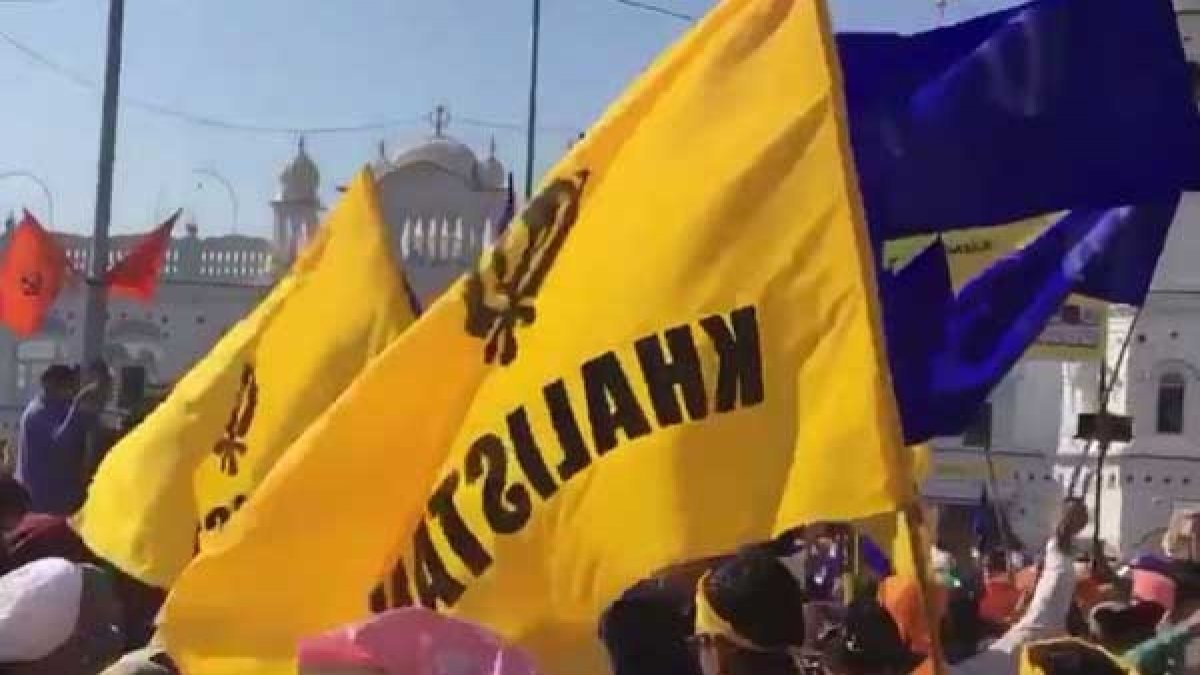The Pak Mischief In Punjab; Inter-Community Goodwill Must Be Retained
By D.C. PATHAK
It is not surprising at all that militancy in the name of Khalistan is being revived in the border state of Punjab, by some groups based abroad and working under the operational guidance of Pakistan’s ISI.
India’s intelligence set-up is fully aware that in the ’80s and ’90s, terrorism was pushed to a peak in the state largely because of this external input – till a determined counter-terror drive gradually got over the threat.
Operation Black-Thunder was to ensure that the Golden Temple where the top Khalistan militants had taken shelter, would not permit any armed person to enter the premises and would not allow any bullet to be fired towards the latter.
The surrender of the terrorists after many days that the operation lasted gave a blow to the armed Khalistan movement, but significantly Pak ISI in the meanwhile opened a second front in the other border state of Jammu & Kashmir by giving a call for Jehad to intensify cross-border terrorism there.
At the beginning of the ’90s, when the terror in Punjab was fading out, Pakistan planned to replicate the success of Afghan Jehad in Kashmir and dispatched the first group of Taliban Mujahideen to the valley under the dreaded Harkat-ul-Ansar.
Pak ISI even asked its loyalist Hizbul Mujahideen of the Jamaat-e-Islami to help the new group with logistic support thus revealing the frontal role of the former in upscaling terrorism in Kashmir to make up for its loss of ground in Punjab.
Indian agencies were aware of this K2 plan of the adversary. While normalcy returned to Punjab, the terrorist violence in Kashmir touched a new high.
With the arrival of Prime Minister Narendra Modi on the scene, India’s stand against a hostile Pakistan toughened with his government declaring that there would be no talks with Pakistan unless the latter will stop the cross-border terrorism against India.
Cross-border terrorism in Kashmir was countered more effectively after the Indian Parliament removed Articles 370 and 35A from the Constitution and declared J&K and Ladakh as Union Territories to bring them under direct Central rule in August 2019.
In the new situation, Pak ISI – finding it difficult to infiltrate militants – took to the tactics of recruiting youth for organized stone pelting on the security forces to destabilize the state and stepping up covert use of social media to intensify radicalization for ‘raising ‘lone wolves’ to carry out terror acts in Kashmir mostly on local policemen and Kashmiri Pandits.
The Sino-Pak axis also became active against India as was evident from the use of Chinese drones by Pakistan for dropping arms and ammunition in the valley to keep up terrorism. These two hostile neighbors also intensified the anti-Indi’ campaign ‘against the ‘annexation’ of Kashmir by India.
Gradually but steadily, India has succeeded in bringing down the level of violence in Kashmir and implementing the development agenda of the state.
For some time now, however, Pak ISI has understandably, reverted to the familiar strategy of reviving terror activity in Punjab on the issue of Khalistan to make up for the loss ‘f ground in Kashmir. India’s Intelligence agencies kept close track of this known move of the adversary and advised the Punjab police to step up vigilance.
It is in this context that the anti-India lobbies abroad led by Pakistan, instigated stray Khalistani elements in the US, UK, Canada, Australia, and other places first to step up Sikhs for Justice movement and revive the Bhindranwale cult and then got Amritpal Singh a self-styled Khalistan protagonist based in Dubai, to launch a militant movement to demand a separate homeland for Sikhs.
Amritpal Singh landed in Punjab last year to take over the leadership of ‘Waris Punjab De’ – an organization floated in 2021 – and at a ceremony held at Rode in Moga district, the native village of Bhindranwale, started an ‘Amrit Parchaar’ campaign.
Working to a script, he began this campaign from Anandpur Saheb and soon attracted headlines when with many armed supporters, he stormed Ajnala Police Station near Amritsar carrying Guru Granth Saheb as a shield, in February this year, to force the release of an associate who had been detained earlier for involvement in a case of violence.
The Punjab police have now woken up to the threat of revival of Khalistan terror – the AAP government might have been caught in two minds earlier, about the possible political fall-out of any strong action against the activities of Amritpal Singh – and has started cancelling arms licenses of his followers.
Significantly, Amritpal Singh’s social media handler was recently arrested at Amritsar International airport as he landed from London- this comes as a confirmation of the external links that are primarily guiding the Khalistan movement.
The modus operandi of Pak ISI is evident again in the planning of initial steps that are meant to gradually create the environment for militancy in Punjab. Drones have been used to drop arms and drugs in the border districts to exploit the vulnerability of Sikh youth and stray incidents of terror are beginning to occur in which enemy agents were using grenades and IEDs to target Police and foment public scare.
The state authorities should be vigilant against any activity designed to create Hindu-Sikh schism – in the days of Khalistan terrorism in Punjab in the ’80s, targeting of Hindu passengers in buses and terror attacks on Hindu leaders had become particularly pronounced.
Amritpal Singh has talked of injustice to the state under a ‘Hindu regime’. State Intelligence must spread to the ground for detecting mischief makers in time for deterrent action. A new challenge is the scanning of social media and covert online communications used by the adversary for recruiting agents of terror.
Border districts of Punjab need closer attention and it is to be borne in mind that the facility of the Kartarpur corridor could be misused by Pak ISI for increasing its outreach.
It should be remembered that the end to terrorism in Punjab came last time when Hindus and Sikhs showed unity against the forces that had shattered the communal harmony for serving the narrow agenda of Khalistan.
Security of the border state must be kept above domestic politics. Guru Nanak is revered by both Hindus and Sikhs and Sikhism is known to have safeguarded the larger Indian society.
Amritpal Singh has incidentally talked of freeing Punjab of drugs to protect the youth there – he is using that to give a positive spin to his subversive movement – but the learning is to have the menace of drugs tackled firmly without letting it create any communal ripples.
The concerned agencies of the Centre and the state must work in a coordinated way and, in appropriate cases, explore the route of rehabilitation of the affected youth, as well.
It is instructive to recall how in the terror-affected Punjab in the ’80s, there was talk of families witnessing the phenomenon of one brother getting seconded to the Khalistan movement while the other would take care of the land or traditionally join the Indian Army.
There is no question of this kind of thing happening again as Sikhs have a pride of place as a martial race and as a savior of the nation.
Separatism injected from outside cannot succeed but the mischief of the adversary must be guarded against.
Against the backdrop of the narrative of authoritarianism and intolerance built by anti-India lobbies against the Modi government, inter-community goodwill must be maintained in the border state and a service-oriented administration was provided to the people in general.
It is also a fact that the state of unemployment in Punjab makes the youth vulnerable to subversive propaganda. A strategic measure would be to place Punjab in the care of a national security professional who had experience of serving the state in difficult times, as Governor for a few years so that the elected government could benefit from this arrangement.
The emerging scene of militancy being restarted in Punjab in the name of Khalistan, by some elements maneuvered by Pakistan, needs to be taken cognizance of and analyzed as one more element of the multi-prong ‘proxy war’ conducted by India’s adversaries- more so by the Sino-Pak axis.
India’s determined move to carry out the military build-up on the LAC in Ladakh to take on any aggressive activity of PLA and simultaneously enhance its collaboration with Quad partners to check Chinese designs in the Indo-Pacific is also the reaffirmation of the Modi government of its right to carry out a surgical strike against Pakistan to counter cross- border terrorism, have together proved to be a sound strategy for India. This has, of course, resulted in deeper collusion between Pakistan and China in stepping up activities that might internally destabilize this country – ranging from civil society groups being floated to sustain anti-India narratives to the use of social media channels covertly to recruit terrorists.
Attacks on strategic targets representing India’s economic strength are a definite threat considering how national security had become inseparable from economic security.
What India needs the most now is strong national unity and it is important that our domestic politics must not do anything that would detract from it.
(The writer is a former Director of India’s Intelligence Bureau. Views expressed are personal)






Daljit (Dean) Singh
/
Mr. D.C. Pathak is in a state of disorder in defining issues and problems in Punjab because of the revival of the Khalistan movement in the state. The scope of his analysis is too wide and diffused, ill-defined, and deserves a finer treatment of genuine grievances of minorities under the BJP party rule. It is not only the Sikhs who have been short-changed in the new Indian investment schemes, most other minorities living in the State of Punjab and elsewhere are economically suffering from maltreatment and neglect. Let us call these events to spade a spade.
Historically, Sikhs share the same roots in the tree of the Indian civilization as all other religions having been born in the Indus Valley. They all share common philosophical and social traditions. There is no one religion superior to the others. It is clearly wrong to propagate otherwise. It is better to focus on economic disparity and its consequences instead of external influence on the Khalistan movement.
March 25, 2023